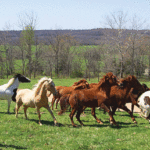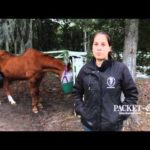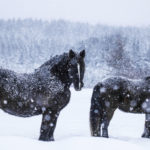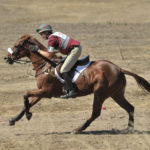One of the major problems facing owners of older horses is simply keeping up their weight. While common, it does not need to be inevitable. Attention to management, sound nutritional information and some creative meal preparation can result in good body condition even in the advanced years.
Concerns
Poor appetite and digestive problems are enough to deal with; you definitely want to eliminate any other factors within your control. Older horses should not be fed in groups — even groups of older horses. Those at the bottom of the pecking order will receive little or no feed.
Stress also influences appetite and digestion. Avoid exposure to extremes of temperature, either hot or cold. Make sure there is shelter from severe storms and biting winds. Monitor the horse closely for signs of illness or worsening/new lameness. Try to avoid changes in the horse’s social situation. Newcomers will often be aggressive to the oldest/weakest in the group as they struggle to establish their own place.
Religious deworming is an absolute must for older horses. Their intestinal-tract immunity often begins to drop off in older age (e.g., they become susceptible to roundworms again), and they can ill afford any parasite damage. (See December 1997 “Quest vs. Zimecterin.”)
Equally important is dental care. Difficult-to-reach points that the dentist may have skipped over in the horse’s younger years will come back to haunt him now. Twice yearly dental examinations and filing should be done — some horses require more. If the horse lives long enough you will have to deal with broken/lost teeth. (See April 1998 “Wake-Up Call To Dentists.”)
The horse should definitely be vaccinated for any disease that poses a risk but avoid vaccines he does not need as these are an unnecessary stress. For example, influenza vaccine has a greater-than-average chance of producing moderate-to-severe soreness, fever and loss of appetite. If the horse is not exposed to horses that come and go frequently, he is at low risk of flu and can be spared that stress.
Chronic pain is a common cause of poor appetite. Arthritis is the No. 1 culprit and likely to plague virtually every older horse to some degree. Daily turnout helps prevent the horse from becoming too stiff. Use of joint nutraceuticals (glucosamine, Perna, chondroitins) can make a tremendous difference in mobility and attitude (see November 1997 “Cartilage Supplements Help Treat Arthritis”). Avoid nonsteroidals (bute, aspirin) and corticosteroids, if possible, as side effects are more likely and more devastating in older horses.
Regular long-term use of alternatives such as MSM, yucca, boswella, devil’s claw or aloe may allow you to eliminate the “hard drugs.” Don’t expect overnight miracles, however. Yucca is reported to take from “three days to three months” to be effective, and you may not be able to eliminate drugs entirely.
Palatability And Feed
Once you have the horse as healthy and stress-free as you can, you need to formulate a diet that the horse both finds appealing and can eat efficiently. Top-quality ingredients are a must when feeding older horses. Don’t think that because he is not doing much of anything he doesn’t need high-grade feed and hay. Loss of digestive efficiency, time required to eat and drops in appetite mean every mouthful must count. Molasses and oils will often increase palatability and also provide extra calories with little bulk.
Extruded feeds are often touted as good for older horses because they are easier to chew. However, the extrusion process results in lower caloric density (fewer calories per volume), which means the horse will have to eat more. This often negates any benefits of this processing.
Pellets may be a good choice, if the horse accepts them. They are easier for the horse to chew than many whole grains and can easily be soaked and made into a mash for horses with few teeth.
If the horse is still able to chew reasonably well, processed grains (cracked, crimped, steam-rolled), usually in a sweet mix, are preferable to whole grains as they are somewhat easier to digest. Added fat may make feeds more palatable and is more calorie-dense.
Nutritional Requirements
The older horse must deal with reduced ability to absorb and digest his feed, which is partially related to inefficient chewing and partially to intestinal factors. The different needs identified include requirement for higher protein, calcium and phosphorus. Reduced efficiency of the hind gut (where roughage/fiber digestion occurs) makes it advantageous to include energy sources that are readily absorbed from the small intestine, such as fat. Studies have also shown that vitamin C blood levels in older horses are lower than in younger adults (see sidebar Aging, Free Radicals and Anti-Oxidants).
It is currently recommended that diets contain 12 to 14% protein, an absolute minimum of 0.3% calcium and 0.25% phosphorus and be supplemented with vitamin C. Older horses also often need a more calorie-dense ration, even with inactivity, as a higher percentage of the nutritional value of the feed may be lost in the manure. High-quality protein (not just a high percentage) with the correct mix of amino acids is also extremely important.
Roughage And Concentrate
Because older horses take longer to chew, often have touchy appetites and decreased digestive efficiency, grain is almost always a necessary part of their diet.
However, they do require adequate roughage to maintain the health of their large intestine. If the horse is still reasonably efficient at chewing, the base of the diet should be a high-quality, early-cutting mixed hay, no more than 50 percent alfalfa to avoid mineral excess/imbalance. Such a hay will also usually contain the target protein level of 12 to 14%.
For horses whose chewing is not quite up to par but which are still able to handle hays, a chopped forage product will do some of the work for the horse and also guarantee he receives a consistent source of high-quality roughage.
Triple Crown sells both a Premium Chopped Grass Blended Forage and a Premium Chopped Alfalfa Blended Forage.
Both products are grown and harvested under carefully controlled conditions by Montana Pride (High Mountain Ranch, Inc.) and are 25 to 40% more digestible than most hays, because they are harvested at an early stage. The grass product has 9.5% protein, the alfalfa 16% (minimums), and both have added molasses and corn oil for improved palatability and higher caloric density.
For older horses whose chewing is not seriously impaired, simple grains can be used as their concentrated calorie source, with or without supplemental vegetable oil. However, because efficiency of other parts of the intestinal tract declines with age, grains must be processed to make them easier to digest. Rolling, cracking, crimping and steam flaking (the latter currently considered the best method) are all helpful. However, once the interior of the grain has been exposed to air you begin to lose fatty acids and vitamins. Plain hay/grain diets will also need mineral supplementation to boost calcium and phosphorus levels as well as trace minerals. Ideally, hay and grain should be analyzed and supplements chosen by the results.
Regular use of small (one to two pounds of bran) bran mashes encourages appetite, improves digestive efficiency, provides supplemental water and also goes a long way in making up the phosphorus deficit present in most equine diets (adequate total phosphorus in the diet but calcium present in excess, causing a ratio of calcium to phosphorus higher than ideal).
Commercially available equine diets are often the best route to take when maximizing nutrition in older horses. However, not all “senior” diets are created equal. Read the label. Calcium and phosphorus levels should be at least the recommended minimum level given above (most contain almost twice those amounts). Total protein/crude protein should be 12 to 14% and come from high-quality sources (alfalfa, milk products, brewer’s byproducts in addition to the commonly used soybean meal or corn gluten meal) to ensure a wide variety of amino acids.
Look for products that add lysine, methionine and sometimes threonine. These amino acids are often in short supply in common feedstuffs and their specific inclusion in the feed means the manufacturer is paying attention to protein quality. Added fat (5 to 8% fat instead of the usual 3%) is a plus.
Fiber content of complete (complete = no need to feed hay) senior feeds should be 15 to 18%, no higher. Higher fiber means fewer calories and more bulk for the horse to consume. Look for a feed that adds vitamin D, B vitamins and vitamin C. (Vitamins B and C are usually not included on the label; contact the manufacturer to find amounts.)
The ingredients will often tell you much about quality. Ingredients that appear first are usually in the highest amounts. Look for beet pulp, brewer’s grains and/or byproducts, milk products, wheat middlings and alfalfa meal. Beet pulp is a particularly good base for older horses as it is an adequate fiber source, but more calories are more in line with concentrates. However, it is digested slowly in the large intestine and provides a steady, constant source of energy. Trace minerals should be present in a chelated form for best absorption. Inclusion of yeast cultures and other probiotics is also a plus.
When using commercial feeds, follow manufacturer’s instructions with regard to how much hay can be fed with the feed, if any. Inclusion of excessive hay or other types of grain/concentrate will disrupt the mineral balance of the feed.
If you have difficulty finding a high-quality senior feed, a mare/foal feed may be your next best choice. Calcium and phosphorus levels may be somewhat higher than required, but if the ratio is ideal this will not be a problem. Otherwise, such things as energy density/calories, protein amount and quality, fiber, vitamins and minerals and overall quality is better than that found in most other mature horse feeds and are suitable for older horses. A quality performance feed may also fill the bill.
Also With This Article
Click here to view “Digestive Aids.”
Click here to view “A Sampling Of Senior Feeds.”
Click here to view “Key Elements In Older Horse Diets.”
Click here to view “Few Or No Teeth.”
Click here to view “Glucosamine Highs.”
Click here to view “Case History.”
Click here to view “Aging, Free Radicals And Anti-Oxidants.”
Contact Your Local Feed/Tack Store Or:
Vita-Key
PO Box 823
Decatur, TX 76234
800/539-8482
www.vita-key.com
Triple Crown
Equine Specialty Feeds
319 Barry Ave. S #303
Wayzata, MN 55391
800/451-9916
www.triplecrownfeed.com
Seminole Feed
PO Box 940
Ocala, FL 34478
800/683-1881
www.seminolefeed.com
United Vet Equine/MVP
14101 West 62nd St.
Eden Prairie, MN 55346
800/328-6652
www.unitedvetequine.com
Buckeye Feeds
PO Box 505
Dalton, OH 44618
330/828-2251
Ration Plus
S.E. Monroe Inc.
PO Box 585 Irvington, VA 22480
800/728-4667
www.rationplus.com
Nu-Weight
Select The Best
PO Box 1968
Carson City, NV 89702
702/246-3022
Sho Glo
Manna Pro
3158 N 7th St. Trafficway
Kansas City, KS 66115
913/621-2355
Blue Seal Feeds, Inc.
15 Buttrick Road
Londonderry, NH 03053
603/437-3400







